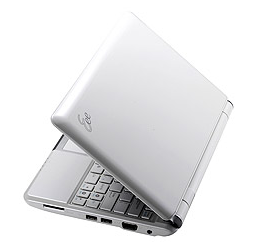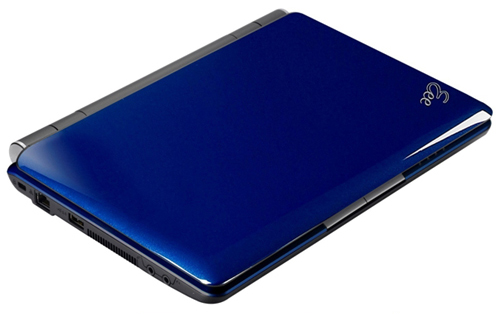ASUS Eee PC 1000HE Netbook - A Home and Office Powerhouse?
Conclusion
The ASUS Eee PC 1000HE’s battery life is nothing short of spectacular. It also provides quite acceptable performance for most business computing tasks. I wouldn’t hand it to a heavy duty spreadsheet or database user, but for the average office worker who needs a mobile computer, the 1000HE would be a fine choice. Add a USB keyboard, a mouse and a low cost monitor, and you’ve got a pretty good desktop alternative for that average office worker. And, of course, you’ll need XP Pro for office networking.
For the record, that white 1000HE to the left isn't available in the USA. There are two color choices, black and blue. Hey, it's ASUS's choice, not mine.
But, how about a standard notebook as an alternative to a netbook? Toshiba’s L305-S5891 notebook is a pretty good example. At this writing, it is selling for $580 on Toshiba's website. It comes with a 2.0GHz processor, 2GB of PC6400 memory, a 160GB 5400RPM SATA-II hard disk drive, 15.4 inch display with a resolution of 1280x800, and Windows Vista Home Premium. The L305-S5891 weighs about 5.5 pounds, compared to the 1000HE’s 3.25 pounds. It’s the functional equivalent of my two year old $1600 Toshiba M200-ST2002 notebook with a slight processor upgrade and an upgrade from SATA-I to SATA-II. As with the 1000HE, for business networking use, you’ll need to upgrade the operating system to a business-friendly one. The Toshiba comes with MS Works 9.0, so, as with a netbook, you can use Works, upgrade to Office 2007, or go for a version of OpenOffice.
But, what if your goal is small size and weight in a more standard notebook? Well, that's where netbooks shine. Ultraportables are not only expensive, as much as 4 or 5 times the cost of the 1000HE, but they also tend to be smaller than the 1000HE.That means you're going to be working with a cramped keyboard and touchpad. In the past, ultraportables were only for top execs. Today, they're sort of the equivalent of a failing bank or auto maker buying a new corporate jet. Listen up, corporate execs, want to appear fiscally responsible. Take a 1000HE to those Congressional hearings.
One final point, no netbook manufacturer is offering business level warrantys in the two to three year range. Repairs and parts for the current crop of netbooks are covered for a one year period, 6 months for batteries. That's what ASUS offers on the 1000HE. If you're used to having a stable of exactly the same computers for a couple to three years, don't count on it with netbooks. The manufacturer's right in the warranty to replace the computer with a newer model rather than repair it, if it fails during the warranty period, is far more likely to to be invoked with netbooks. Then again, at the rate netbooks are being significantly upgraded, the possibility of swapping a last generation netbook for a newer one is at least somewhat attractive and could be worth making new images for mass cloning of under warranty replacements. Oh yes, that Toshiba L305-S5891 doesn't come with a business level warranty either.
In the end, the choice between a netbook like the Eee 1000HE and a standard notebook like the Toshiba L305-S5891 boils down to cost, weight and needed functionality. If netbook functionality is enough, then, today, a netbook will set you back about 65% less than a standard notebook like the Toshiba. The $205 price difference between the two computers may not seem like much when you’re buying only one computer, but if you need 25, 50 or 100, that difference becomes significant, especially in today’s economy.
The ASUS Eee PC 1000HE is not yet widely available. However, you can find it here.
Get Tom's Hardware's best news and in-depth reviews, straight to your inbox.
-
cadder I have wanted a netbook for casual use and travel, because they are small and cheap, even though I have a very fast desktop and 2 15" laptops, one of which is pretty powerful. My wife wanted a small and light laptop for Christmas so I ended up buying her a 12" Toshiba. It cost 3 times what some netbooks cost, and even though it has a 1.4GHz processor, it is about twice as fast as a netbook. I wasn't sure if a netbook would be fast enough for her, and I'm sure she would not have been happy with the smaller screen and keyboard. I think the netbooks are probably plenty powerful, and eventually they will evolve more to blend in with the smaller laptops. Hopefully they won't get more expensive in the process. With good battery life as a plus, this ASUS seems like a good model and I agree that lots of people could use it as their only computer, even some business travelers.Reply -
caiusmartius123 I want a netbook soooo bad, but I still feel that 1024 x 600 is UNACCEPTABLE, at any size. That is the 1 thing holding me back and has held me back for so long. Why can't they just use a 1280 x 800 (better) or a 1366 x 768 (optimal) panel? I'm not asking for full 1080p (and at screen sizes of 10" and 12" that would be stupid and unecessary).Reply
I can't be the only who feels this way after using a netbook with a 1024 x 600 screen. -
From what I've read, XP is the problem. MS decided to restrict resolutions on the XP they allow for Netbooks to 1024x600, so manufacturers are making the screens that resolution.Reply
-
cleeve 1024x600 is a very usable resolution on this size of screen if you've ever tried it.Reply
Even the older 800x480 screens were passable to get the job done, although sometimes you'd have to scroll the screen. But with 1024x600, this is much less of a problem. -
barryegerber I can remember far enough back to the days of the Compaq luggable portable with a 9 inch 25 line by 80 character screen, it weighed 28 pounds and was a great way to lengthen your arms. I carried two of them, one in each arm, across the San Francisco airport one miserable day. I always remember that day whenever I get misty about the good old days. http://oldcomputers.net/byte-compaq.html.Reply
-
presto311 I own a 1000H and love it. I successfully ran windows vista for a few months and now have the windows 7 beta installed. I did upgrade to 2 gigs of ram though. It runs the OS great, even with aero running. The 1024x600 resolution hasn't really been a problem. If it was increased anymore stuff would be too small to see. I highly recommend this netbook. Great all around. I have a powerful desktop for gaming and everything else, so this netbook is perfect for school to use for internet and taking notes. I occasionally watch tv shows on it too and it works fine!Reply -
radguy Netbooks are pretty neat but you should expect these devices to do what they are designed for. Its small low power very portable internet laptop device. Yes it can do a lot more than surf the web but it was meant as a device to pull out at the coffee shop and check email or go online. I waited for a long time and finally picked up the 3 cell msi wind for 300 bucks with a coupon. on xp it handels just about anything I have thrown at it but games ( I tried farcry, fear, and several others that I had problems with because they wanted a cd install and after 2 hours off trying to get around it gave up). But office, itunes, movies, the occasional time wasting games like snood and peggle). I installed win 7 and have been very happy. It doesn't have the speed of xp but it runs fine as long as you don't try to do too much at once. I put an extra gig of ram and turbo mode is really nice. I will note the battery sucked buy I bought a 6 cell.Reply
My problem with the eee 1000H was the looks more than anything. the 1000HE is a slight improvement but the 1002 would be better. However the N280 without the better chipset isn't worth the extra money so we wait for the new chipset. The battery life does make it a very nice deal for the price though.
The product isn't really a laptop and even though you can buy a nice 13 inch laptop for 600 bucks which I would recomend if needed more speed. The xp, atom, gma 950 does more than what need for the basics. It should be noted that most of the people who would read this would want more than the basics so take that into consideration before judging the product. I am hoping for some better designs and upgraded tech for the 12 inch ish market at about 400-500 but intels atom and windows xp restictions are causing some major problems with that.
Thanks for the review
-
presto311 bosjeeI don't understand why all these manufactures cannot make the netbook any thinner.Reply
There are a few reasons. I think mostly they want to keep the cost down, since that's one of the main concepts. Cheap, basic, portable, simple. The parts and engineering for an ultra slim like the mac air require more money to produce.

